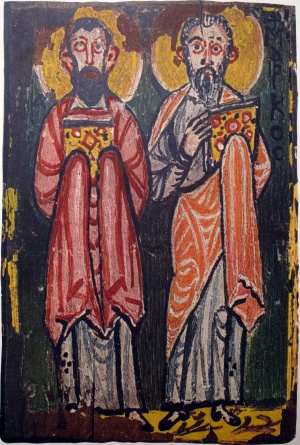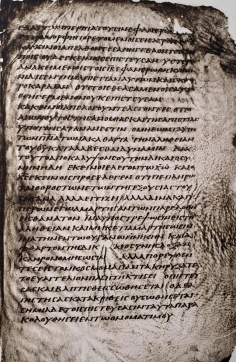Codex Washingtonianus
From Textus Receptus
(→Text of codex) |
(→Text of codex) |
||
| Line 30: | Line 30: | ||
: It reads λεγοντες ειρηνη τω οικω τουτω instead of αυτην. The reading is used by manuscripts: [[Codex Sinaiticus|Sinaiticus*<sup>,2</sup>]], [[Codex Bezae|Bezae]], [[Codex Regius (New Testament)|Regius]], [[Codex Koridethi|Koridethi]], [[Family 1|''f'' <sup>1</sup>]] 1010 (1424), it vg<sup>cl</sup>. | : It reads λεγοντες ειρηνη τω οικω τουτω instead of αυτην. The reading is used by manuscripts: [[Codex Sinaiticus|Sinaiticus*<sup>,2</sup>]], [[Codex Bezae|Bezae]], [[Codex Regius (New Testament)|Regius]], [[Codex Koridethi|Koridethi]], [[Family 1|''f'' <sup>1</sup>]] 1010 (1424), it vg<sup>cl</sup>. | ||
| - | [[Matthew 23:3]] has the reading " | + | [[Matthew 23:3]] has the reading "παντα ουν οσα εαν ειπωσιν ὑμιν τηρειν τηρειται και ποιειται · κατα δε τα εργα αυτων μη ποιειται· λεγουσιν γαρ και ου ποιουσιν." in basic agreement with Majority Text (and practically with D) against the United Bible Society's "ποιήσατε καὶ τηρεῖτε" (on the understanding that αι iota is an allophonic variation for ε). |
It has an addition in [[Mark 1:3]], the citation from Is 40:3 is longer. Mark 10:48 is omitted as in codex [[Minuscule 1241|1241]]. | It has an addition in [[Mark 1:3]], the citation from Is 40:3 is longer. Mark 10:48 is omitted as in codex [[Minuscule 1241|1241]]. | ||
Revision as of 04:00, 27 March 2015
The Codex Washingtonianus or Codex Washingtonensis, designated by W or 032 (in the Gregory-Aland numbering), ε 014 (Soden), also called the Washington Manuscript of the Gospels, and The Freer Gospel, contains the four biblical gospels and was written in Greek on vellum and palimpsest in the fourth or fifth century. The manuscript is lacunose.
Contents |
Description
The codex is a book of 187 leaves of 20.5-21cm by 13-14.5cm with painted wooden covers, consisting of 26 quires (four to eight leaves).
The text is written in one column per page, 30 lines per page. There are numerous corrections made by the original scribe and a few corrections dating to the late 5th or 6th century. John 1:1-5:11 is a replacement of a presumably damaged folio, and dates to around the seventh century. It is missing Mark 15:13-38 and John 14:26-16:7. The ink is dark brown. The words are written continuously without separation. Accents are absent. The rough breathing is used very rarely.
Like in Codex Bezae the Gospels follow in Western order: Matthew, John, Luke, Mark.
The following nomina sacra are written in abbreviated forms: ΘΣ ΚΣ ΧΡΣ ΙΣ ΠΝΑ ΑΝΟΣ ΠΗΡ ΜΗΡ ΥΣ ΔΑΔ (ΔΔ once) ΙΗΛ (ΙΣΡΛ once).
Matthew 16:2b-3 is present and not marked as doubtful or spurious. Luke 22:43-44, John 5:4 and the Pericope de adultera are omitted by the scribe.I t lacks Matthew 5:21-22 (as Minuscule 33), and Luke 19:25 (as Codex Bezae, 69, 1230, 1253, lectionaries, b, d, e, ff², syrsin, copbo);
It contains Matthew 23:14, as do manuscripts 0104, 0107, 0133, 0138, and most other Byzantine mss.
Text of codex
The Codex is cited as a "consistently cited witness of the first order" in the critical apparatus of the Novum Testamentum Graece. The codex was apparently copied from several different manuscripts and is the work of two scribes. The text-type is eclectic:
- Matthew 1-28; Luke 8:13–24:53 – Byzantine text-type;
- Mark 1:1–5:30 – Western text-type similar to old-Latin Versions;
- Mark 5:31 – 16:20 – Caesarean text-type near to p45;
- Luke 1:1 – 8:12, and J 5:12 – 21:25 – Alexandrian text-type;
- John 1:1 – 5:11 – mixed with some Alexandrian and Western readings. This text was added in the 7th century, probably for replacement of damaged text.
In Matthew 1:10 it reads Αμων for Αμως (א, B, C), the reading of the codex agrees with L, f13 and the Byzantine text.
- It reads λεγοντες ειρηνη τω οικω τουτω instead of αυτην. The reading is used by manuscripts: Sinaiticus*,2, Bezae, Regius, Koridethi, f 1 1010 (1424), it vgcl.
Matthew 23:3 has the reading "παντα ουν οσα εαν ειπωσιν ὑμιν τηρειν τηρειται και ποιειται · κατα δε τα εργα αυτων μη ποιειται· λεγουσιν γαρ και ου ποιουσιν." in basic agreement with Majority Text (and practically with D) against the United Bible Society's "ποιήσατε καὶ τηρεῖτε" (on the understanding that αι iota is an allophonic variation for ε).
It has an addition in Mark 1:3, the citation from Is 40:3 is longer. Mark 10:48 is omitted as in codex 1241.
In Mark 2:3 it has \ιδου ανδρες ερχονται προς αυτον βασταζοντες εν κρεβαττω παραλυτικον supported only by Old Latin Codex Palatinus instead of usual variant ερχονται φεροντες προς αυτον παραλυτικον αιρομενον υπο τεσσαρων;
In Mark 10:19 — phrase μη αποστερησης omitted, as in codices B, K, Ψ, f1, f13, 28, 700, 1010, 1079, 1242, 1546, 2148, ℓ 10, ℓ 950, ℓ 1642, ℓ 1761, syrs, arm, geo.
In Μark 13:2 it contains addition και μετα τριων ημερων αλλος αναστησεται ανευ χειρων (and after three days another will arise) — D W it.<ref>
In Mark 9:49 it reads πας γαρ πυρι αλισθησεται – as manuscripts (א εν πυρι) B L Δ f1 f13 28 565 700 ℓ260 syrs copsa.
In Luke 4:17 it has textual variant καὶ ἀνοίξας τὸ βιβλίον (and opened the book) together with the manuscripts A, B, L, Ξ, 33, 892, 1195, 1241, ℓ 547, syrs, h, pal, copsa, bo, against variant καὶ ἀναπτύξας τὸ βιβλίον (and unrolled the book) supported by א, Dc, K, Δ, Θ, Π, Ψ, f1, f13, 28, 565, 700, 1009, 1010 and many other manuscripts.
Luke 22:43-44 omitted, as in codices p75, א*, A, B, T, 1071.
In Luke 23:34 omitted words: "And Jesus said: Father forgive them, they know not what they do." This omission is supported by the manuscripts Papyrus 75, Sinaiticusa, B, D*, Θ, 0124, 1241, a, Codex Bezaelat, syrsin, copsa, copbo.
In John 7:1 it reads ου γαρ ειχεν εξουσιαν for ου γαρ ηθελεν, the reading is supported by Old Latin: a, b, ff², l, r1, and by Syriac Curetonian.
Freer Logion
The ending of Mark in this codex is especially noteworthy because it includes a unique insertion after Mark 16:14, referred to as the "Freer Logion".
- Κακεινοι απελογουντο λεγοντες οτι ο ιων ουτος της ανομιας υπο τον σαταναν εστιν, ο μη εων τα (τον μη εωντα?) υπο των πνευματων ακαθαρτα (-των?) την αληθειαν του θεου καταλαβεσθαι (+ και?) δυναμιν δια τουτο αποκαλυψον σου την δικαιοσυνην ηδη, εκεινοι ελεγον τω χριστω και ο χριστος εκεινοις προσελεγεν οτι πεπληρωται ο ορος των ετων της εξουσιας του σατανα, αλλα εγγιζει αλλα δεινα και υπερ ων εγω αμαρτησαντων παρεδοθην εις θανατον ινα υποστρεψωσιν εις την αληθειαν και μηκετι αμαρτησωσιν ινα την εν τω ουρανω πνευματικην και αφθαρτον της δικαιοσυνης δοξαν κληρονομησωσιν.
Translation:
- And they excused themselves, saying, "This age of lawlessness and unbelief is under Satan, who does not allow the truth and power of God to prevail over the unclean things of the spirits [or: does not allow what lies under the unclean spirits to understand the truth and power of God]. Therefore reveal thy righteousness now" - thus they spoke to Christ. And Christ replied to them, "The term of years of Satan's power has been fulfilled, but other terrible things draw near. And for those who have sinned I was delivered over to death, that they may inherit the spiritual and incorruptible glory of righteousness which is in heaven.
This text is not found in any other manuscript, but was partially quoted by Jerome:
et illi satisfaciebant dicentes: Saeculum istud iniquitatis et incredulitatis substantia (sub Satana?) est, quae non sinit per immundos spiritus veram Dei apprehendi virtutem: irdirco iamnunc revela iustitiam tuam.
History
The codex was purchased by Charles Lang Freer on a trip to Egypt in November 1906. Metzger states: "It is only Greek Gospel manuscript of early date of which we know provenance. Though the exact spot in Egypt where it was found is not known, there are indications that it came from a monastery in the neighbourhood of the Pyramids." The writing is closely related to the Codex Panopolitanus (Papyrus Cairensis 10759), Henoch manuscript, found in Akhmim in 1886.
There is a subscription at the end of the Gospel of Mark, written in semi-cursive from the 5th century: "Holy Christ, be thou with thy servant Timothy and all of his." The similar note appears in Minuscule 579. Hermann von Soden cited a number of similar subscriptions in other manuscripts.
It is located in the Smithsonian Institution at the Freer Gallery of Art (06. 274) in Washington, D.C., United States of America, and some of it can be viewed on-line. Complete images of the codex are available from the Rights and Reproductions office at the Freer Gallery of Art.
The manuscript is dated by the INTF to the 4th or 5th century.
See also
References
Further reading
- Caspar René Gregory, Das Freer-Logion (Hinrichs: Leipzig 1908)
- Henry A. Sanders, Facsimile of the Washington Manuscript of the Four Gospels in the Freer Collection, The University of Michigan, Ann Arbor, Michigan 1912.
- Henry A. Sanders, The New Testament Manuscripts in the Freer Collection, The Macmillan Company, New York – London 1918.
- Frederic G. Kenyon, Our Bible and the Ancient Manuscripts, (4th ed.), London 1939.
- Larry W. Hurtado, Text-Critical Methodology and the Pre-Caesarean Text: Codex W in the Gospel of Mark, Studies and Documents 43, Eerdmans 1981.
- Larry W. Hurtado, The Freer Biblical Manuscripts. Fresh Studies of an American Treasure Trove, Brill 2007.


